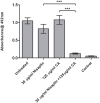A Bioengineered Nisin Derivative, M21A, in Combination with Food Grade Additives Eradicates Biofilms of Listeria monocytogenes
- PMID: 27965658
- PMCID: PMC5127793
- DOI: 10.3389/fmicb.2016.01939
A Bioengineered Nisin Derivative, M21A, in Combination with Food Grade Additives Eradicates Biofilms of Listeria monocytogenes
Abstract
The burden of foodborne disease has large economic and social consequences worldwide. Despite strict regulations, a number of pathogens persist within the food environment, which is greatly contributed to by a build-up of resistance mechanisms and also through the formation of biofilms. Biofilms have been shown to be highly resistant to a number of antimicrobials and can be extremely difficult to remove once they are established. In parallel, the growing concern of consumers regarding the use of chemically derived antimicrobials within food has led to a drive toward more natural products. As a consequence, the use of naturally derived antimicrobials has become of particular interest. In this study we investigated the efficacy of nisin A and its bioengineered derivative M21A in combination with food grade additives to treat biofilms of a representative foodborne disease isolate of Listeria monocytogenes. Investigations revealed the enhanced antimicrobial effects, in liquid culture, of M21A in combination with citric acid or cinnamaldehyde over its wild type nisin A counterpart. Subsequently, an investigation was conducted into the effects of these combinations on an established biofilm of the same strain. Nisin M21A (0.1 μg/ml) alone or in combination with cinnamaldehyde (35 μg/ml) or citric acid (175 μg/ml) performed significantly better than combinations involving nisin A. All combinations of M21A with either citric acid or cinnamaldehyde eradicated the L. monocytogenes biofilm (in relation to a non-biofilm control). We conclude that M21A in combination with available food additives could further enhance the antimicrobial treatment of biofilms within the food industry, simply by substituting nisin A with M21A in current commercial products such as Nisaplin® (Danisco, DuPont).
Keywords: Listeria monocytogenes; bioengineered; biofilm; cinnamaldehyde; citric acid; combinations; nisin.
Figures







Similar articles
-
Lactic Acid Bacteria (LAB) and Their Bacteriocins as Alternative Biotechnological Tools to Control Listeria monocytogenes Biofilms in Food Processing Facilities.Mol Biotechnol. 2018 Sep;60(9):712-726. doi: 10.1007/s12033-018-0108-1. Mol Biotechnol. 2018. PMID: 30073512 Review.
-
The Lipoteichoic Acid-Related Proteins YqgS and LafA Contribute to the Resistance of Listeria monocytogenes to Nisin.Microbiol Spectr. 2022 Feb 23;10(1):e0209521. doi: 10.1128/spectrum.02095-21. Epub 2022 Feb 23. Microbiol Spectr. 2022. PMID: 35196823 Free PMC article.
-
Efficacies of nisin A and nisin V semipurified preparations alone and in combination with plant essential oils for controlling Listeria monocytogenes.Appl Environ Microbiol. 2015 Apr;81(8):2762-9. doi: 10.1128/AEM.00070-15. Epub 2015 Feb 6. Appl Environ Microbiol. 2015. PMID: 25662980 Free PMC article.
-
Enhancement of the Antibiofilm Activity of Nisin against Listeria monocytogenes Using Food Plant Extracts.Pathogens. 2023 Mar 12;12(3):444. doi: 10.3390/pathogens12030444. Pathogens. 2023. PMID: 36986366 Free PMC article.
-
A review of potential antibacterial activities of nisin against Listeria monocytogenes: the combined use of nisin shows more advantages than single use.Food Res Int. 2023 Feb;164:112363. doi: 10.1016/j.foodres.2022.112363. Epub 2022 Dec 28. Food Res Int. 2023. PMID: 36737951 Review.
Cited by
-
Production and Antimicrobial Activity of Nisin Under Enological Conditions.Front Microbiol. 2018 Sep 5;9:1918. doi: 10.3389/fmicb.2018.01918. eCollection 2018. Front Microbiol. 2018. PMID: 30233504 Free PMC article.
-
The Use of Natural Methods to Control Foodborne Biofilms.Pathogens. 2022 Dec 27;12(1):45. doi: 10.3390/pathogens12010045. Pathogens. 2022. PMID: 36678393 Free PMC article. Review.
-
Polyphenolic Antibacterials for Food Preservation: Review, Challenges, and Current Applications.Foods. 2021 Oct 15;10(10):2469. doi: 10.3390/foods10102469. Foods. 2021. PMID: 34681518 Free PMC article. Review.
-
Revisiting the rules of life for viruses of microorganisms.Nat Rev Microbiol. 2021 Aug;19(8):501-513. doi: 10.1038/s41579-021-00530-x. Epub 2021 Mar 24. Nat Rev Microbiol. 2021. PMID: 33762712 Review.
-
Lactic Acid Bacteria (LAB) and Their Bacteriocins as Alternative Biotechnological Tools to Control Listeria monocytogenes Biofilms in Food Processing Facilities.Mol Biotechnol. 2018 Sep;60(9):712-726. doi: 10.1007/s12033-018-0108-1. Mol Biotechnol. 2018. PMID: 30073512 Review.
References
-
- Al-Holy M., Al-Qadiri H., Lin M., Rasco B. (2006). Inhibition of Listeria innocua in hummus by a combination of nisin and citric acid. J. Food Prot. 69 1322–1327. - PubMed
-
- Arqués J. L., Rodríguez E., Nuñez M., Medina M. (2008). Antimicrobial activity of nisin, reuterin, and the lactoperoxidase system on Listeria monocytogenes and Staphylococcus aureus in cuajada, a semisolid dairy product manufactured in Spain. J. Dairy Sci. 91 70–75. 10.3168/jds.2007-0133 - DOI - PubMed
-
- Bari M., Ukuku D., Kawasaki T., Inatsu Y., Isshiki K., Kawamoto S. (2005). Combined efficacy of nisin and pediocin with sodium lactate, citric acid, phytic acid, and potassium sorbate and EDTA in reducing the Listeria monocytogenes population of inoculated fresh-cut produce. J. Food Prot. 68 1381–1387. - PubMed
LinkOut - more resources
Full Text Sources
Other Literature Sources
Research Materials

